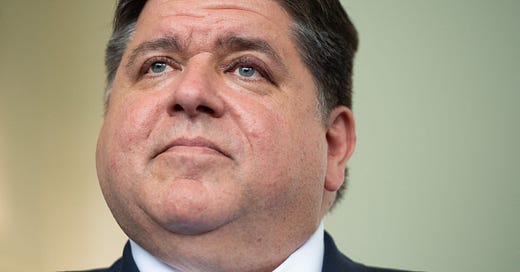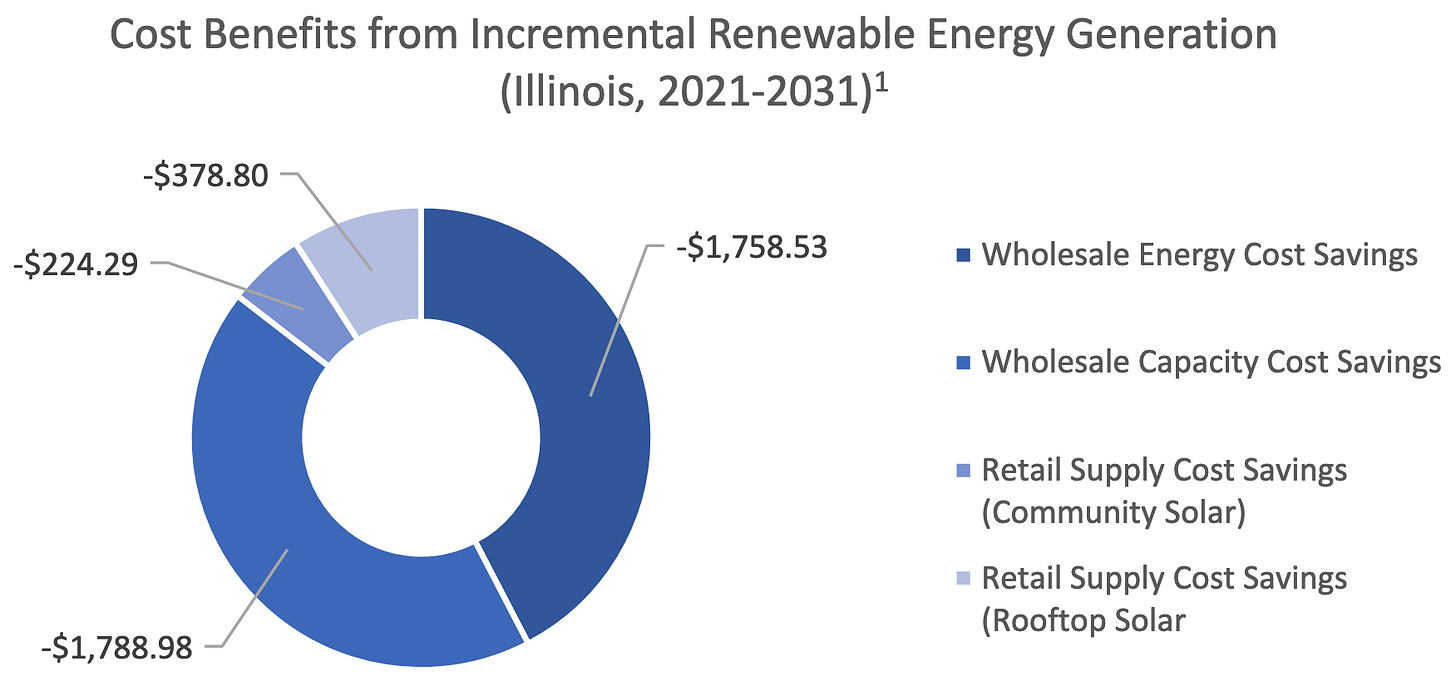In 2016, Illinois passed a decent enough energy bill. It shored up the state’s (relatively modest) renewable energy standard and kept its existing nuclear power plants open. It was a compromise among varied interests, signed into law by a Democratic legislature and a Republican governor. At the time, I figured it was the best any state in the coal-heavy Midwest was likely to do.
Well, that will teach me to go around figuring. Just five years later, Illinois has raised the bar, passing one of the most environmentally ambitious, worker-friendly, justice-focused energy bills of any state in the country: The Climate and Equitable Jobs Act.
Illinois is now the first state in the Midwest to commit to net-zero carbon emissions, joining over a dozen other states across the country. It is also a model for how diverse stakeholders can reach consensus.
What’s changed in Illinois
A great deal has changed since that 2016 bill was passed.
First and foremost, in 2018, Democrats gained a trifecta in state government, increasing their lead in both houses of the Illinois General Assembly and putting Democrat J.B. Pritzker in the governor’s office. As I have emphasized numerous times now, Democratic control is a necessary (if not sufficient) condition for ambitious state energy policy.
Soon after the 2018 election, negotiations over a new energy bill began in earnest.
The state’s labor community was sensitive to the fact that it had largely been left out of the 2016 bill; the legislation contained no labor standards, and recent years have seen Illinois renewable energy projects importing cheaper out-of-state workforces. Labor didn’t want to get left behind in the state’s energy transition, so it organized a coalition of groups under the banner Climate Jobs Illinois and set about playing an active role in negotiations.
Renewable energy developers — cognizant of the fact that Illinois is falling short of its renewable energy goals (it’s at 9 percent; it’s supposed to be at 21) and state funding has dried up for new renewable energy projects — organized as Path to 100.
Environmental and climate-justice groups organized as the Illinois Clean Jobs Coalition.
All the groups introduced energy bills of their own. And then they spent years banging their heads together.
But there was another key difference: this time around, utilities were not at the table.
Exelon subsidiary ComEd had been caught up in a bribery scandal that left it disempowered and weak, under a deferred prosecution agreement. The scandal also led to House Speaker Michael Madigan, a reliable utility ally, being removed from his position.
Utilities were, to put it crudely, on the shit list, allowing political leadership to restrain their historic (and largely counterproductive) influence.
Nonetheless, by all accounts, negotiations were difficult; the bill was declared dead several times. Senate President Don Harmon (D) said several times that it is the single most complex piece of legislation he’d ever worked on. There were uncertainties and impasses right up through the final week.
But they got it done! It passed with bipartisan supermajorities: 83-33 in the House and 37-17 in the Senate. Pritzker signed it on September 15.
One crucial piece of the puzzle was new political leadership, from Pritzker on down. Harmon, who became Senate president in 2018, is a longtime champion of renewable energy. In January 2021, Rep. Chris Welch, a widely respected deal-maker, replaced Madigan as House Speaker. Welch pursued what his office calls “distributed, collective leadership” — key members of the House Democratic leadership took responsibility for acting as liaisons to the legislature’s Black caucus, the environmental community, and coal communities.
By all accounts, everyone performed their roles ably, holding an unwieldy coalition together through choppy waters. Illinois politics reporter Rich Miller has a nice rundown of the final passage, which he calls “a spectacular victory.”
From the beginning, everyone involved was more or less aligned around rapid growth of renewable energy and full decarbonization of the electricity sector by 2045.
The most contentious issue proved to be the schedule for decarbonization. The environmentalists in the Clean Jobs Coalition wanted steady 20 percent reductions every five years, starting in 2026. The labor groups in Climate Jobs Illinois were worried that shutting down fossil fuel plants that fast would lead to the state being forced to import fossil fuel power from out of state, sacrificing jobs to no environmental gain.
Particularly thorny was a municipally owned coal plant, the 10-year-old Prairie State Energy Campus in southwestern Illinois, which is the state’s biggest greenhouse gas emitter and a horrendous financial boondoggle that costs more to run than its power is worth.
Part of the problem is that the plant, owned by a consortium of nine public power agencies, was largely funded by municipal bonds from the communities meant to receive its power; those communities were worried they’d get stiffed if the plant retired early. (Enviros claimed they could close the plant, use the savings to pay off the bonds, and still come out ahead, but that was met with some skepticism.)
To make a long story short: first Pritzker wanted the plant’s retirement date at 2035. Then he agree to 2045. Then Senate Democrats voted through a plan that would have let the plant pump out 100 percent of its current emissions through 2045. That was unacceptable to environmentalists and Pritzker, who wanted interim reduction targets. That flummoxed the process for a bit, but in the end, labor agreed to it.
Even after that, there was some last-minute drama from the governor’s office, leading to a stalemate with Harmon; finally, they agreed to kick the bill over the House, where Welch dragged it over the finish line.
Anyway, that’s probably more process drama than you wanted. Let’s look at what’s in the bill.


Clean energy and good wages, justly distributed: the Illinois energy bill
I’m not going to cover the entire 900-page bill. We’ll just hit the highlights.
Emission reductions and clean electricity
Today, Illinois gets about 40 percent of its electricity from nuclear power and less than 10 percent from renewable energy. The new renewable portfolio standard (RPS) will raise renewables’ share to 40 percent by 2030 and 50 percent by 2040, with the goal of a zero-carbon electricity sector by 2045 — and beyond that, a net-zero-carbon state economy by 2050. This is extremely ambitious and a new benchmark for the Midwest.
Subsidies to renewable energy will roughly double, to around $580 million per year. An additional $317 million the big utilities had previously collected will be spent on clean-energy projects rather than refunded to customers as scheduled. (It’s a long story.)
The popular Illinois Solar for All program, which helps get rooftop solar power to low-income renters and homeowners (as well as public buildings and nonprofits serving environmental justice communities), will have its funding increased from $10 million to $50 million a year.
Obviously, Illinois will have much more trouble hitting its decarbonization targets if its nuclear power plants shut down, so the bill provides the Byron, Dresden, and Braidwood plants with about $700 million in subsidies over the next five years. (The size of the subsidy, considerably less than the $5 billion Exelon wanted, was informed by an independent analysis commissioned by the governor’s office.)
All private coal- and oil-fired power plants must get to zero emissions (i.e., retire) by 2030. Municipally owned coal plants — Prairie State and Dallman Station — must reduce emissions 45 percent by 2035 (which will mean shutting down one of two boilers) and 100 percent by 2045.
All private natural gas plants must reach zero emissions — either by retiring or by switching over to hydrogen — by 2045. Until then, their emissions in a given year can not exceed the average of the previous three years, i.e., can not rise. (Plants can stay open if a government assessment finds that they are necessary for grid reliability.)
Importantly: fossil fuel plants will be shut down according to their proximity to low-income and marginalized communities, not necessarily according to greenhouse gases or economics.
Every five years starting in 2025, the Illinois Environmental Protection Agency, the Illinois Power Agency, and the Illinois Commerce Commission (ICC) must produce a report on the state’s progress toward its renewable energy goals.
The ICC will also begin developing a renewables access plan to increase electricity transmission throughout the state.
For the record: a recent study led by former Illinois Power Agency Director Mark Pruitt found that getting to 40 percent renewable energy by 2030 “would deliver over $1.2 billion in lower total electricity costs for Illinois.”
Transportation decarbonization
The bill establishes the goal of getting a million electric vehicles on Illinois roads by 2030. In part, that will be achieved through a $4,000-per-vehicle rebate for EV customers (which, added to the EV credit in the current federal bill, would mean a combined rebate of $16,500). Electric utilities will be required to submit clean-electrification plans to the ICC, showing how they plan to drive EV adoption.
The Illinois Environmental Protection Agency will rebate up to 80 percent of the cost of EV infrastructure projects that pay prevailing wages. Forty-five percent of those rebates will be channeled to projects in low-income and marginalized communities.
Labor and equity standards
All utility-scale renewable energy projects that qualify under the state’s RPS must use project-labor agreements; all non-residential clean-energy projects must pay prevailing wages. All projects must demonstrate through diversity hiring reports that they have recruited qualified BIPOC candidates and apprentices.
As far as I know, this gives Illinois the most stringent labor and equity requirements of any state clean energy program. Similar policies tying renewable energy projects to labor standards have passed in Connecticut, New York, and Washington, but no other state’s energy policy has as comprehensive a package of labor, diversity, and equity standards.
Workforce development and transition assistance
The bill will create an $80 million-a-year Clean Jobs Workforce Network Hubs Program, which will create 13 hubs around the state to deliver workforce-development programs to low-income and underserved populations. Resources will be put toward outreach, recruitment, training, and placement.
The Department of Commerce and Economic Opportunity and the Illinois Department of Employment Security will work together to develop a “displaced worker bill of rights,” with $40 million a year to go toward transition assistance for areas dependent on fossil fuel production or generation.
There will be two green bank–style programs. The Clean Energy Jobs and Justice Fund will provide financing and low-interest lending to clean-energy projects in low-income and marginalized communities. The Illinois Finance Authority Climate Bank, more like a conventional green bank, will provide seed funding and develop public-private partnerships to draw more private capital to clean energy projects.
A clean energy incubator program will offer support and low-interest capital to small energy businesses and contractors, to the tune of over $35 million a year. There will be a program to train and place soon-to-be-released incarcerated people in clean-energy fields. And there will be a program meant to encourage the development of solar and storage on the site of closed fossil-fuel plants, to help employ laid-off workers.
An Energy Transition Workforce Commission will report on the workforce needs of a decarbonizing economy and recommend further changes to workforce policies.
The Department of Commerce and Economic Opportunity will create a program to reduce energy transition barriers, a grant program to promote economic development in transitioning communities, and a scholarship fund for children in families of laid-off workers.
Notably, companies intending to shut down fossil fuel plants will be required to give affected communities two years’ notice, so that such communities can be identified and receive transition assistance.
Consumer protections
For low-income ratepayers, the bill eliminates deposit requirements and late fees; it eliminates online payment fees for all ratepayers.
Utilities will be required to report their monthly shutoffs and reconnections to the ICC, and the ICC will conduct a comprehensive study of the level and design of low-income rates to ensure that they are working effectively.
Utilities will be required to fund the participation of nonprofit representatives in ICC proceedings, to increase community participation.
Finally, munis and co-ops will be prohibited from charging discriminatory fees to ratepayers that self-generate solar electricity (as investor-owned utilities already are).
Utility ethics and rate reforms
Some of these details get technical, but the gist is that the bill contains a range of specific ethics reforms — for example, public officials must declare if any of their relatives work for utilities — and creates a Public Utility Ethics and Compliance Monitor to make sure utilities are implementing those reforms. In addition, each utility must appoint a Chief Ethics and Compliance Officer who reports to the ICC.
ComEd is prohibited from forcing ratepayers to pay any criminal penalties or fines associated with its ongoing federal corruption probe.
Excitingly for us utility nerds, the bill will end “formula ratemaking” — an opaque process whereby rates are automatically increased based on how much utilities are spending, with no need for approval from regulators — in favor of “performance-based ratemaking,” which ties utility compensation to a series of performance metrics such as “reliability and resiliency, peak load reductions attributable to demand response programs, supplier diversity expansion, affordability, interconnection response time, and customer service performance.” This is good stuff.
An independent auditor will assess the state of the Illinois grid and the money spent on it over the last decade.
Utilities will be required to file a Multi-Year Integrated Grid Plan that supports the state’s renewable energy targets. They will undergo yearly performance evaluations to track how well they are meeting their planning goals.
Finally, and intriguingly, ICC will create a Division of Integrated Distribution Planning, meant to increase public input in local distribution grid decisions.
Illinois is showing how democracy should work
Over the last three years, climate hawks, environmental justice advocates, renewable energy developers, and labor gathered around a table and worked through their differences about the future of Illinois’ energy system, freed from the usual odious influence of utilities.
It was an anxious, fractious, and often white-knuckle process, right up until the very end. No constituency got everything it wanted; each made sacrifices. I expect there’s still quite a bit of residual frustration and some fresh bruises that will take a while to heal.
But to my outside eye, representatives from each of these groups can return to their constituents with heads held high. The bill is a model of non-zero-sum cooperation: every group gave a little to get a lot.
A special shout-out goes to the environmental-justice community in Illinois, which used three years of relentless grassroots organizing to build an incredible political force, without which the bill couldn’t have passed and wouldn’t have been as equity-focused.

For all the disputes at the margins, the resulting bill is momentous, a historic inflection point for Illinois. The state is now a national leader — and a challenge to the rest of the Midwest — in how to transition to clean energy while creating good jobs and lifting up those often left behind.
An aggressive transition to clean energy can be good for the economy, good for workers, good for historically marginalized communities, good for the air, and good for the atmosphere. We can have nice things. More and more states are figuring that out.
Congratulations to Illinois, particularly to its new generation of political leaders, for figuring it out with such populist flair.
















Share this post